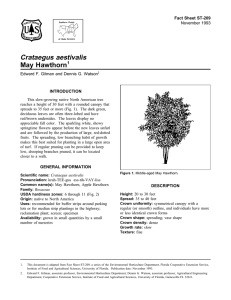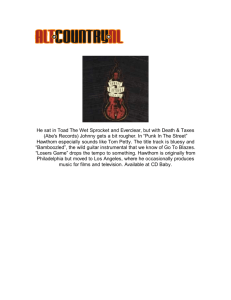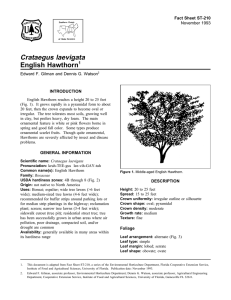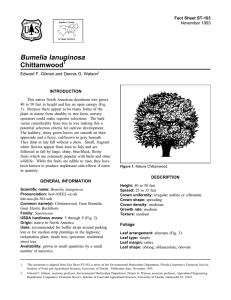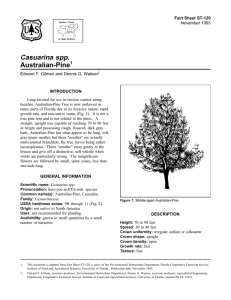Crataegus x lavallei Lavalle Hawthorn Fact Sheet ST-215 1
advertisement
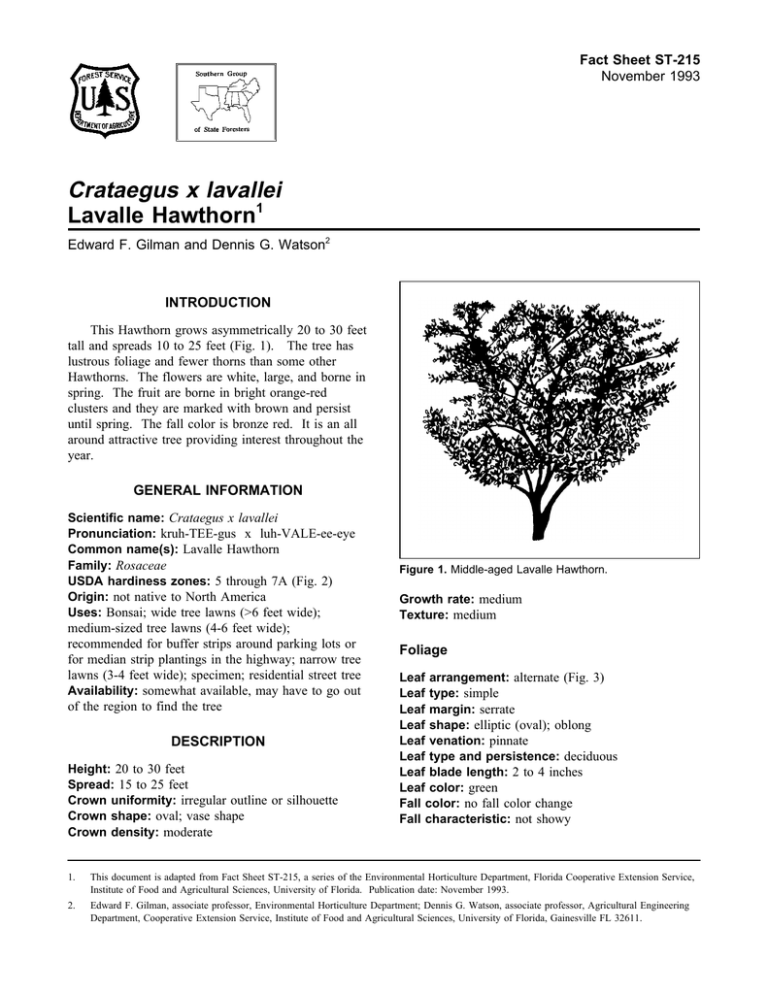
Fact Sheet ST-215 November 1993 Crataegus x lavallei Lavalle Hawthorn1 Edward F. Gilman and Dennis G. Watson2 INTRODUCTION This Hawthorn grows asymmetrically 20 to 30 feet tall and spreads 10 to 25 feet (Fig. 1). The tree has lustrous foliage and fewer thorns than some other Hawthorns. The flowers are white, large, and borne in spring. The fruit are borne in bright orange-red clusters and they are marked with brown and persist until spring. The fall color is bronze red. It is an all around attractive tree providing interest throughout the year. GENERAL INFORMATION Scientific name: Crataegus x lavallei Pronunciation: kruh-TEE-gus x luh-VALE-ee-eye Common name(s): Lavalle Hawthorn Family: Rosaceae USDA hardiness zones: 5 through 7A (Fig. 2) Origin: not native to North America Uses: Bonsai; wide tree lawns (>6 feet wide); medium-sized tree lawns (4-6 feet wide); recommended for buffer strips around parking lots or for median strip plantings in the highway; narrow tree lawns (3-4 feet wide); specimen; residential street tree Availability: somewhat available, may have to go out of the region to find the tree DESCRIPTION Height: 20 to 30 feet Spread: 15 to 25 feet Crown uniformity: irregular outline or silhouette Crown shape: oval; vase shape Crown density: moderate Figure 1. Middle-aged Lavalle Hawthorn. Growth rate: medium Texture: medium Foliage Leaf arrangement: alternate (Fig. 3) Leaf type: simple Leaf margin: serrate Leaf shape: elliptic (oval); oblong Leaf venation: pinnate Leaf type and persistence: deciduous Leaf blade length: 2 to 4 inches Leaf color: green Fall color: no fall color change Fall characteristic: not showy 1. This document is adapted from Fact Sheet ST-215, a series of the Environmental Horticulture Department, Florida Cooperative Extension Service, Institute of Food and Agricultural Sciences, University of Florida. Publication date: November 1993. 2. Edward F. Gilman, associate professor, Environmental Horticulture Department; Dennis G. Watson, associate professor, Agricultural Engineering Department, Cooperative Extension Service, Institute of Food and Agricultural Sciences, University of Florida, Gainesville FL 32611. Crataegus x lavallei -- Lavalle Hawthorn Page 2 Figure 2. Shaded area represents potential planting range. Flower Culture Flower color: white Flower characteristics: showy; spring flowering Light requirement: tree grows in full sun Soil tolerances: clay; loam; sand; acidic; alkaline; Fruit Drought tolerance: high Aerosol salt tolerance: low Soil salt tolerance: poor well-drained Fruit Fruit Fruit Fruit Fruit shape: round length: .5 to 1 inch covering: fleshy color: orange; red characteristics: does not attract wildlife; no significant litter problem; persistent on the tree; showy Trunk and Branches Trunk/bark/branches: droop as the tree grows, and will require pruning for vehicular or pedestrian clearance beneath the canopy; not particularly showy; should be grown with a single leader; thorns are present on the trunk or branches Pruning requirement: needs little pruning to develop a strong structure Breakage: resistant Current year twig color: green Current year twig thickness: medium Other Roots: surface roots are usually not a problem Winter interest: tree has winter interest due to unusual form, nice persistent fruits, showy winter trunk, or winter flowers Outstanding tree: not particularly outstanding Invasive potential: little, if any, potential at this time Verticillium wilt susceptibility: not known to be susceptible Pest resistance: very sensitive to one or more pests or diseases which can affect tree health or aesthetics Crataegus x lavallei -- Lavalle Hawthorn Page 3 Spider mites are so small they can cause much foliage discoloration before being detected. Diseases Figure 3. Foliage of Lavalle Hawthorn. USE AND MANAGEMENT The tree is used extensively as a street tree in some areas of the country because they are tough. It is an excellent garden shrub border plant, providing a refreshing white bloom in spring, fall color, and attractive fruit. Specify tree-form when planting along the street. Pests Aphids can be partially controlled with strong sprays of water from a garden hose, if the colony is in the lower branches. Sometimes the aphids themselves are not seen but the distorted growth, honeydew on the leaves, and sooty mold growing on the honeydew are obvious. Borer attacks may be prevented if the trees are kept in good vigor with regular fertilization. Leaf miners symptoms are brown blotches on the leaves. Lace bugs can be a serious, though occasional, problem. The insect feeding on the undersides of the leaves causes chlorotic flecks on the upper leaf surfaces. The lower sides of the leaves are covered with small, brown, sticky flecks. The pear slug skeletonizes Hawthorn leaves and these sawfly larvae have a slimy appearance. A few insects can be washed off with a garden hose. Tent caterpillar nests can be pruned out while still small. Sprays of Bacillus thuringiensis may be used. Do not burn nests while the nests are in the tree. The injury from the fire may exceed that caused by the insects. Overwintering scales can usually be controlled with horticultural oil sprays. Fire blight: This disease can be severe in some parts of the country. The first noticeable symptom of fire blight is the browning of branch tips. The tips appear to be burned or scorched and the dead, brown leaves droop but hang on the tree. Cankers form and the bacteria is washed farther down the branch by rain. The bacteria are spread from diseased to healthy twigs by bees and contaminated pruning tools. There is no satisfactory chemical control. The disease is less of a problem if trees are not located near apple or pear orchards. Prune out blighted branch tips by cutting a foot or two beyond the diseased wood. Overfertilizing with nitrogen fertilizer may increase tree susceptibility to fire blight. Leaf blight attacks most Hawthorns but especially English Hawthorn. The symptoms are small reddish brown spots on the leaves which may run together. Infected leaves drop in August and severely infected trees may be completely bare. Cedar Hawthorn rust causes orange or rust colored spots on the leaves leading to early defoliation. The fruits and twigs are also attacked. Juniper is an alternate host. Cedar-quince rust attacks fruits. Washington, Lavelle and Cockspur Hawthorn are resistant to rust diseases. Scab causes leaf spotting and defoliation. The fruit have black raised spots on them. Powdery mildew causes a white powdery growth on the leaves.
